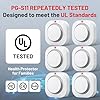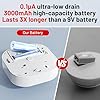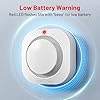A heat detector is a device that senses the presence of heat and triggers an alarm when the temperature reaches a certain level. There are two types of heat detectors: those that measure the temperature of the air and those that measure the temperature of the object.
If you suspect that your heat detector is not working, there are a few simple tests you can do to confirm that the detector is not receiving power.
- Look for power cords or plugs near the detector. If the detector does not have a cord or plug, it may need to be replaced.
- Check for signs of smoke or heat coming from the detector. Smoke and heat indicate that the detector is working.
- Check the batteries in the detector.
Contents
Different types of heat detectors and how to check them
There are two main types of heat detectors- rate-of-rise and fixed temperature. Rate-of-rise heat detectors are designed to detect a rapid increase in temperature, while fixed temperature heat detectors are activated when the temperature reaches a certain threshold.
To check a rate-of-rise heat detector, simply hold it in your hand and release the test button. The detector should sound an alarm within seconds. To check a fixed temperature heat detector, you will need to use a heat source, such as a hair dryer, to raise the temperature of the detector to its threshold.
Heat detectors are an important part of any fire safety system, as they are designed to detect fires in their early stages. This allows you to take action to extinguish the fire or evacuate the building before it gets out of control.
Heat detectors should be checked at least once a month, and more frequently if they are located in areas where there is a lot of dust or other debris.
Why you should check your heat detectors regularly?
Your heat detectors play a vital role in keeping your home or business safe from fires. It is important to check them regularly to ensure they are in good working order. There are a few different ways to check your heat detectors.
One way to check your heat detectors is to use a heat detector tester. This is a handheld device that you can use to test the sensitivity of your heat detectors. You will need to follow the manufacturer’s instructions on how to use the tester.
Another way to check your heat detectors is to visually inspect them. You should look for any signs of damage, such as cracks or chips in the housing. You should also check the wiring to make sure it is secure and not damaged.
If you have any concerns about your heat detectors, you should contact a professional. They will be able to give you more information about how to check them and what to do if there are any problems.
How to check for proper operation of your heat detectors?
There are two ways to check the proper operation of your heat detectors. The first is to use an infrared camera. This will allow you to see if the heat detector is detecting heat. The second way is to use a heat detector tester. This will allow you to test the heat detector to see if it is working properly.
Tips for maintaining your heat detectors
1. Check the batteries regularly. Heat detectors, like any other type of detector, rely on batteries to function. Most heat detectors have a low battery indicator to let you know when the batteries need to be replaced.
2. Test the detector regularly. Most heat detectors have a test button that allows you to test the detector to make sure it’s working properly.
3. Clean the detector regularly. Dust and dirt can build up on the detector, causing it to not work properly. Use a soft, dry cloth to gently wipe the detector clean.
4. Replace the detector when necessary. Heat detectors have a limited lifespan and will eventually need to be replaced. Check the manufacturer’s recommendations to find out how often you should replace your heat detector.
How to troubleshoot heat detector problems?
If you have a problem with your heat detector, there are a few things you can do to troubleshoot the issue. First, check the batteries to make sure they are fresh and have a good connection. Next, check the wiring to make sure it is secure and free of any damage.
Finally, check the detector itself to make sure it is clean and free of any debris. If you still have problems with your heat detector, you may need to replace it.
When to replace your heat detectors?
It is important to regularly check your heat detectors and replace them when necessary. Heat detectors are one of the most important pieces of safety equipment in your home, and they should be checked at least once a year. If you live in an area with a lot of wildfires, you may need to check them more often.
There are two types of heat detectors: ionization and photoelectric. Ionization detectors are more sensitive to smaller fires, while photoelectric detectors are more sensitive to larger fires. You should have both types of detectors in your home.
To check your heat detectors, hold a match near the detector. If the detector goes off, it is working properly. If it does not go off, you will need to replace it.
The importance of having working heat detectors
in your home or office cannot be overstated. A heat detector is a device that senses the presence of heat and raises an alarm when it detects a fire.
Heat detectors come in two main types: spot type and line type. Spot type heat detectors are designed to be placed in specific areas, such as near a stove or in a room where a fire is most likely to start. Line type heat detectors are placed along walls or in hallways and can detect heat anywhere along their length.
There are two main types of heat detectors: those that use a fixed temperature threshold and those that use a rate-of-rise threshold. Fixed temperature heat detectors are triggered when the temperature rises to a certain level, such as 150 degrees Fahrenheit. Rate-of-rise heat detectors are triggered when the rate of temperature increase exceeds a certain amount, such as 10 degrees Fahrenheit per minute.
Most heat detectors have a test button that allows you to test the device to make sure it is working properly. To test a fixed temperature heat detector, simply press the test button and hold it for a few seconds. The detector should sound an alarm.
To test a rate-of-rise heat detector, press the test button and then quickly move the detector to a location with a different temperature, such as a window. The detector should sound an alarm if the temperature difference is significant.
If your heat detector is not working properly, it is important to replace it as soon as possible. A heat detector that does not work could result in a devastating fire.
Summary
It is important to check your heat detector regularly to ensure it is working properly. You can do this by testing the alarm with a heat source, such as a hair dryer. Hold the hair dryer about six inches from the detector and turn it on to the highest setting. The alarm should sound within 30 seconds. If it does not, then the detector needs to be replaced.



















